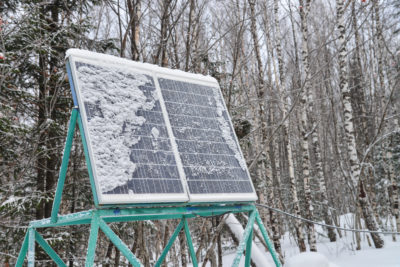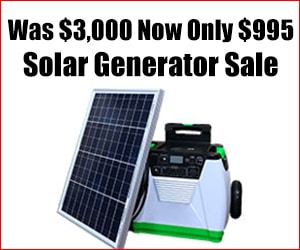
By maximizing your solar generator, you can ensure that you will be completely prepared for anything that a winter storm may throw at you.
If you go far enough back in history, you’ll find that the whole idea of disaster preparedness and survivalism started in northern climates as a response to Old Man Winter. People who have lived in colder climates have faced winter freezes and heavy snowfalls. They learned that they had to have enough food to survive. Otherwise, they weren’t going to make it through the winter.
Maximizing Your Solar Generator When Harsh Weather Knocks Out The Grid
Winter is the most dangerous time of year for those of us who live in northern climates. We have to contend with snow, ice and blizzards. Even with our modern infrastructure largely eliminating the possibility of starvation, danger still exists. Many people are no more than one blizzard away from death.
Starvation is by no means the only danger that winter brings, nor is it the greatest danger. In modern society, the most likely thing a winter blizzard is going to bring is the loss of electric power. Such power outages are a common occurrence in winter storms as ice accumulates on power lines, weighing them down to the point of breaking.
We all know that without electrical power, our nation comes to a grinding halt. We are dependent on electrical power for virtually everything. From communications to heating to preserving and cooking our food, we need that electrical power.
That’s why it’s a good idea to have some sort of backup power source such as a solar generator. Solar generators have a distinct advantage over any other sort of electrical power generator since they don’t need any fuel. The sun, with its virtually inexhaustible supply of fuel, provides all the power these generators need.
Maximizing Your Solar Generator: Keep Your Unit Ready For Action
However, if you’re going to depend on a solar power generator to give you solar power when the power company can’t, you need to be ready to use that generator. Part of that means making sure the generator is ready to use.
I’ve seen countless people buy solar power generators, try them out, and then store them away in a dark closet somewhere. They will never see these units again until they are needed. What that does is guarantee that the battery is not at full charge when a person needs their generator. Forgive me for saying so, but that’s just about as foolish as you can get.
If you have a solar power generator, then you need to store it in a proper way. You need to make sure that it is connected, ready for use, and that the solar panel is constantly exposed to sunlight. That way, the solar panel is consistently maintaining the charge of the battery so that when it is needed, it is ready. You can easily accomplish this by putting the solar panel in a window or on the roof of your garage. I keep mine on the top of a utility trailer that I use for storage.
Maximizing Your Solar Generator Through Spare Batteries And Extra Solar Panels
Don’t use the solar power generator on a regular basis unless it is to do things that require minimal energy. For instance, I have some LED lights connected to mine. They provide a minimal level of lighting in my garage and storage areas. This setup allows me to go into those areas without having to turn on the lights. There’s clearly no way that these lights will draw as much power as the solar panels generate in a day. Consequently, there is no way they are going to run down the battery even if I leave them on.
It’s also a good idea to buy a spare battery or two for your solar generator. Many companies make their generators in such a way that there is space to mount a second battery or there is an add-on battery sold for them. This is a great idea. When the time comes that you need to use the power in your solar generator, you will be drawing from the actual battery and not the solar panel. Meanwhile, the solar panel will be recharging that battery for you so that you can continue using it.
That’s another area where you can maximize your solar generator: the solar panel. Many of these have provisions for adding an additional panel, which a company may sell as an accessory. What the additional panel does for you is reduce the charging time by increasing the amount of sunlight converted to electricity. In turn, you will have more power available for your use.
Maximizing Your Solar Generator: Choose Compatible And Energy Efficient Appliances
Finally, one of the things that few people bother with is making sure they have electrical devices to use which will run off the power produced by their solar power generator. Granted, these systems usually have 120 volt AC outlets on them so that you can plug in whatever electronics you have. Nevertheless, the batteries in the units store the power at 12 volts DC just like your car battery. Boosting this level to 120 volts AC consumes a lot of power. So, if you are able to run a 12-volt device off it, you get more mileage for your battery.
Basically, you want energy efficient devices which will run off of 12 volts. These would include appliances which are capable of connecting to a car’s accessory connector/cigarette lighter. A 12-volt coffee pot, for example, will draw much less power from the battery in your solar generator than your normal coffee maker that you plug in at home. That means you can make more coffee or have power left over for other uses.
Maximizing the effectiveness of your solar power generator is an important part of your preparedness strategy. It’s great to have a device like this if at all possible. Notwithstanding, it’s even better to be able to gain the greatest benefit out of them when the time comes that we need to use them.
Readers that want to take advantage of wholesale pricing on one of the more reliable solar generators can visit mysolarbackup.com for more information
You may also enjoy reading an additional Off The Grid News article: Freezing Temperatures And Winter Power Outages
Do you have any other tips or suggestions about maximizing your solar generator during wintertime blackouts? Let us know in the comments below.



























